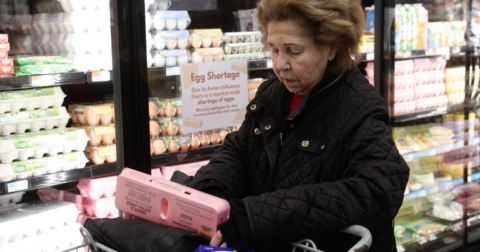Feature
Heat Exhaustion, Amputated Fingers, Crushed Limbs: The Hidden Cost of American Turkey
Food•8 min read
Solutions
Drone footage obtained by animal rights group proved crucial to settlement negotiations.


Words by Jessica Scott-Reid
For decades, the meat industry has been attempting to thwart undercover investigations with so-called “ag-gag laws,” state laws that criminalize the unauthorized recording of livestock farm operations. One way investigators have persisted, however, is with the use of drone technology, which can enable investigators to document conditions on farms that may not align with the claims on the label. Drone footage supplied key evidence in a case brought by animal advocacy group Animal Outlook against Alderfer Poultry Farm, Inc., a Pennsylvania egg brand that advertised its eggs as “free-roaming,” when footage revealed some of these hens were not afforded better welfare conditions in reality.
Alderfer has now agreed to settle the lawsuit for $287,500 and pledged to remove the “free-roaming” claim from its products. The company’s eggs are sold in stores in the Northeast and Mid-Atlantic states, according to Animal Outlook. Sentient contacted Alderfer for comment but did not receive a reply.
Ben Williamson, executive director of Animal Outlook, tells Sentient he believes this is the first case in which a drone has been used to legally prove that an egg producer was making misleading claims. Piper Hoffman, senior director of legal advocacy for Animal Outlook tells Sentient that some of the spaces for hens in the footage were narrow, metal and bleak. “We saw no birds on the ground outside,” she says. “I don’t know if they ever saw the sun.”
Drone footage from several Alderfer farms was taken by Animal Outlook in partnership with photojournalism organization We Animals in December 2023. The footage revealed that some hens labeled as “free-roaming” were in fact only provided small, covered and wire-floored porches that could only accommodate a fraction of the flock. Other farms appeared to provide animals with no outdoor access at all.
“For years the industry has gotten away with cruelty to animals by having huge walls that were only ever impenetrable by undercover investigations,” Williamson says. “Being able to fly drones from a public sidewalk on the street — public property over the top of a facility — allows us to see what’s going on behind those walls.”
The case, an action for consumer protection brought in the District of Columbia, and represented by Richman Law & Policy, also utilized consumer surveys to prove that Alderfer’s “free-roaming” claims were misleading the public. The surveys confirmed that when consumers looked at the true images of the brand’s egg facilities, “that was not what they expected from the term ‘free-roaming,’” says Hoffman.
Similar research conducted in Canada in 2024 found that when consumers were shown various “free run” packaging examples, only 14 percent correctly answered that the hens are still held indoors 24/7. According to Bryant Research, 68 percent “mistakenly believed these hens are housed in better conditions with outdoor space.”
Pamela Vesilind, assistant professor of law at Vermont Law School, explains why these surveys are critical: “You find overwhelmingly that consumers think free-roaming means one thing, when, in fact, that’s not at all what it means in this situation.”
Some labelling claims made on eggs are legally defined by the United States Department of Agriculture’s (USDA’s) Agriculture Marketing Service. This includes “cage-free” and “free-range.” The agency does not define “free-roaming,” allowing the producer to evade the regulatory requirements.
USDA-graded eggs labeled as “cage-free” must provide hens the ability to roam freely within the facility and to “engage in natural behaviors.” These hens are not required to have access to the outdoors, but can and are often held in massive, windowless, warehouse-type barns.
USDA-graded free-range eggs are produced by hens who have the same indoor access as cage-free hens, but also must have continuous access to the outdoors during their laying cycle. Outdoor areas may be fenced or covered with netting. There is no mention of natural groundcover, grass or sunlight.
These specific labels, according to the USDA, “must undergo a review process to verify the claim is truthful.” These visits often happen once per year, or as little as every two years.
According to Animal Outlook’s Piper Hoffman, egg producers don’t have to participate in the voluntary USDA grading program, and if they don’t, they aren’t subject to USDA verification visits if they use either “free-range” or “cage-free.” As for “free-roaming,” says Hoffman, “there’s no regulation at all,” and no USDA oversight to verify the free-roaming label’s accuracy.
The use of class action lawsuits against egg producers is a popular tactic for advocates for farm animals. Two Illinois residents are currently suing Eggland’s Best Inc. in a class-action lawsuit in Chicago, over allegedly misleading claims that “cage free” hens are “free to roam in a pleasant, natural environment.” The plaintiffs argue that the hens are actually confined indoors in crowded, concrete windowless facilities. While this may meet “cage-free” requirements, “These hens are not ‘free to roam’ anywhere, and their living conditions are neither ‘natural’ nor ‘pleasant,’” they argue in the complaint.
The egg industry, like much of the food industry writ large, is no stranger to misleading marketing. Various terminology around housing and handling, made with varying degrees of oversight — whether by government agencies, voluntary third parties or no one at all — make the egg-buying landscape confusing for consumers.
Despite modest space improvements passed in a handful of states, around 60 percent of hens farmed for eggs in the U.S. are still confined to battery cages. These are the smallest cages allowed by law, providing at minimum 67 square inches of space — less than a sheet of paper — per bird for the majority of their lives.
The Alderfer case points to a larger problem of misleading claims on food labels. While consumers may seek higher-welfare eggs, the label on the carton does not necessarily reflect reality.
For now, Williams says he hopes this case will serve as an example for other animal protection organizations “that they can use cutting-edge photography to investigate other claims such as free-roaming in their jurisdictions, and hopefully make a difference for the lives of egg-laying hens around the world.”